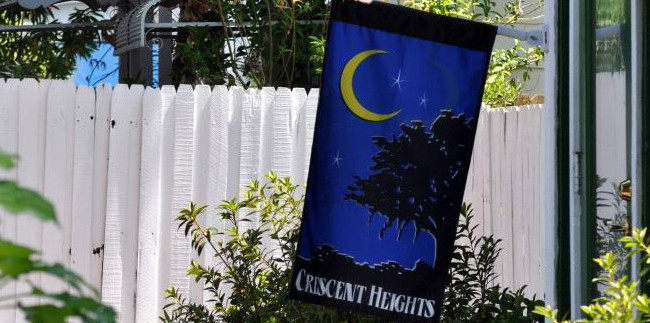Crescent Heights Realtor St. Petersburg

Crescent Heights lies just north of beautiful Crescent Lake Park, which contains a large spring fed lake, a playground, tennis courts, dog park and several landscaped acres of family fun. The people who make Crescent Heights their home are a conglomeration of retirees, young families and professionals.
Crescent Heights Architecture
The largest percentage of homes in Crescent Heights was built in the 1920’s and 1930’s, and range from Florida Bungalows, Frame Vernacular, Colonial Revival and a smattering of Mediterranean Revival, just to name a few. Most of the homes include such amenities as pine or oak flooring, large eaves, front porches and uniquely built-in features such as custom cabinets flanking brick fireplaces. Many homes are two bedroom bungalows, however, large two story three and four bedroom homes are also common.
The variety of home styles and size makes Crescent Heights attractive to retirees who wish to downsize, first time homebuyers who wish to build equity and families who are attracted to the larger homes in the neighborhood. In recent years, Crescent Heights has started attracting buyers who are attracted by all that the neighborhood has to offer and wish to refurbish homes that are available at a reasonable price. Refurbished home sales in Crescent Heights have attracted the attention of the local realtors and square footage prices of homes are on the rise. Crescent Heights has adopted the NDR (Neighborhood Design Review) mandate in cooperation with the city of St.Petersburg to help ensure the preservation of the neighborhood’s profile.
History of Crescent Heights
 In 1842 the Governor of Florida, with the Congress, declared it open to homesteaders with the “Armed Occupation Act”. By 1860-1880 many speculators and land developers began to acquire large holdings throughout Florida. Alfred Neelds had land in the 4th Street and Crescent Lake area during 1873. William C. Murphy owned 40 acres in the area of 24th Avenue and 4th Street. The Lake Butler Villa Co. owned the area which extends from 17th Avenue to 30th Ave. and from 7th Street to 4th Street in 1877.
In 1842 the Governor of Florida, with the Congress, declared it open to homesteaders with the “Armed Occupation Act”. By 1860-1880 many speculators and land developers began to acquire large holdings throughout Florida. Alfred Neelds had land in the 4th Street and Crescent Lake area during 1873. William C. Murphy owned 40 acres in the area of 24th Avenue and 4th Street. The Lake Butler Villa Co. owned the area which extends from 17th Avenue to 30th Ave. and from 7th Street to 4th Street in 1877.
These early pioneers bought, sold and traded land tracts often due to various events. The Civil War, hurricanes and land speculation contributed to these events. Many tracts were inherited by their descendents and often subdivided and sold during several land booms. During the early 1900’s most of this area was citrus groves, virgin pine timber, and open range for cattle. There were a few farm and ranch homes in these outlaying parts. Recorded in 1907 is the Shepherd home, “way out in the country”, at the southeast corner of what is now 8th Street and 29th Avenue North. About 1905 to about 1925 two land booms had taken place resulting with considerable development in the area.
In the areas just North of Crescent Lake, of what is now 22nd Avenue to 30 Avenue North and from 9th Street to 4th Street North certain developers were establishing several subdivisions. The “Piedmont Place” subdivision was platted Nov.7, 1912. The developer C. W. Springstead platted the subdivision “Spring Hill” in Jan.27, 1913. “Florida Heights” was platted March 3, 1917. The “Crescent Park Heights” subdivision, was formed when group of owners had formed a partnership by combining their land to form the Crescent Park Heights subdivision. They were Jim D. Griner, W. H. Prichard, W. C. Foster, A. T. Anderson, Mrs. Grace Watkins, E. B. Kilgore and G.R. Sechler. The subdivision was platted Oct. 14, 1922.
 Most of the homes are of the 1920’s-1950’s era. Many were built as bungalows for winter visitors. Larger homes were built for wealthy retiree’s. Famous residents included Mrs. Mueller, of Mueller’s Macaroni, who has a home built on 7th Street. In addition, an apartment building on 24th Avenue served as the spring training home for Babe Ruth when the New York Yankees trained at the Miller Huggins-Stengel Field at the south end of Crescent Lake. Many of the residents are proud of the historical significance of their neighborhood. Several projects have been undertaken to increase the historical awareness and to preserve the heritage of it.
Most of the homes are of the 1920’s-1950’s era. Many were built as bungalows for winter visitors. Larger homes were built for wealthy retiree’s. Famous residents included Mrs. Mueller, of Mueller’s Macaroni, who has a home built on 7th Street. In addition, an apartment building on 24th Avenue served as the spring training home for Babe Ruth when the New York Yankees trained at the Miller Huggins-Stengel Field at the south end of Crescent Lake. Many of the residents are proud of the historical significance of their neighborhood. Several projects have been undertaken to increase the historical awareness and to preserve the heritage of it.
Approximately 50-60% of the homes in Crescent Heights would qualify as a historical landmark site. One such home, as shown below, has been designated as “The Remington House”, a historical landmark site on 24th Avenue North.
Association and Activities
The neighborhood association began in 1989. The name “Crescent Heights” was chosen when one resident commented that her home had a concrete sign in the yard with the engraving of “Crescent Heights”. Also the area’s topography is at a higher elevation north of Crescent Lake. The organization itself was formed primarily as a social organization to facilitate neighbors to congregate, talk and share information.
 Monthly meetings are held the third Tuesday of the month at 7:00 p.m. at the American Baptist Church on the corner of 28th Avenue and 8th Street. There are no meetings in August and December. A newsletter is distributed to all homes in the neighborhood by a volunteer pool of newsletter deliverers. The newsletter is written and produced by the newsletter coordinator. The meetings generally contain about 15-30 minutes of association business followed by an informative speaker. They have had speakers on the following subjects: lawn and garden, reclaimed water, home improvements, recycling, the City’s Recreation Department, crime prevention and personal safety, among others. Other recurring programs include neighborhood garage sales, annual block party and the adoption of a needy family at Christmas. Neighborhood grant projects
Monthly meetings are held the third Tuesday of the month at 7:00 p.m. at the American Baptist Church on the corner of 28th Avenue and 8th Street. There are no meetings in August and December. A newsletter is distributed to all homes in the neighborhood by a volunteer pool of newsletter deliverers. The newsletter is written and produced by the newsletter coordinator. The meetings generally contain about 15-30 minutes of association business followed by an informative speaker. They have had speakers on the following subjects: lawn and garden, reclaimed water, home improvements, recycling, the City’s Recreation Department, crime prevention and personal safety, among others. Other recurring programs include neighborhood garage sales, annual block party and the adoption of a needy family at Christmas. Neighborhood grant projects
The Crescent Heights Neighborhood Association has received over $25,000 since 1999 to improve and preserve the neighborhood. In 1999, the association received a grant to develop a neighborhood plan. This plan identified aspects of the neighborhood that the residents wanted to preserve and set goals for the future improvement and development.The plan was officially approved by the St. Petersburg City Council in July of 2000.
In the year 2000, another neighborhood grant was awarded to the association for four marker pillars designating the four major entryways into our neighborhood. An additional matching grant was awarded in 2002 for historical lightning to be installed at and to complement the four entryway markers





